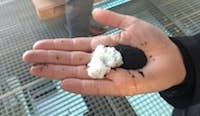International engineering and project management consultancy Royal HaskoningDHV has joined with Dutch water supply company Vitens to help other drinking water companies around the world recover humic acid, an organic fertilizer.
Humic acid is often discharged currently as a waste product during the drinking water blanching process. With this technology, it can now be reclaimed sustainably in its pure form, providing an organic soil improver.
Royal HaskoningDHV will be marketing the Dutch technology, which won the international Aquatech Innovation Award 2013, on a global scale. Lieve Declercq, chair of the Vitens executive board and Esther Bosman, Royal HaskoningDHV’s director of water technology in the Netherlands, signed a partnership agreement to this effect on Jan. 8, 2015.
“Royal HaskoningDHV and Vitens are two very different players in the water market," Bosman said. "We both have our own interests and yet we are able to join forces. We now have a unique Dutch innovation at our disposal which will present a solution to global challenges. Together, we will be able to make a difference and contribute to the circular economy.”
The drinking water production company Spannenburg, in the Dutch province of Friesland, provided the platform for Vitens to apply its combination of technologies—ion exchange and various existing membrane technologies—to blanch drinking water. This process creates a residual stream of water and salt as well as humic acid, a valuable organic substance from peaty soil that gives water a yellowish hue. Water and salt are completely reused during the production process while the humic acid, once regarded as a waste product, can now be utilized as a soil improver in the agricultural sector.
“Thanks to the sustainable usage of humic acid, we are able to reduce the use of artificial fertiliser and phosphates in agriculture and horticulture. This will improve the ground water used to produce drinking water, and the growth of crops, as well as being better for the environment," Declercq said. "In short: a win-win situation for farmers and water supply companies. I am happy that, thanks to Royal HaskoningDHV, we are now able to share this knowledge with other water companies around the world.”
Bosman emphasized the international opportunities for this technology: “Royal HaskoningDHV has identified a market potential for this sustainable chain technology. Take Spannenburg for example. An average of 25 million cu meters of water is pumped up here every year, incorporating enough humic acid to serve all of Dutch agriculture and more. And we have identified opportunities in the U.K., the Republic of Ireland and Scandinavia as well. There is also a financial advantage as a residual substance costing money is being replaced by a valuable product.”
Humic acid occurs in coal and lignite as well as peat, and Europe currently usually uses a chemical process on lignite imported from the U.S. and Australia to extract the acid. This process has an adverse effect on the environment, and is also expensive because of transport costs. The new technology will help drinking water companies recover humic acid from their own water, while also reclaiming a sustainable and local product easily and without any chemical effect on the environment.
Source: Royal HaskoningDHV


